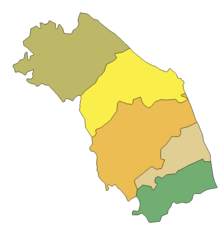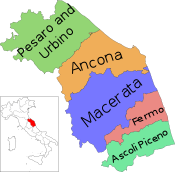Marche
Marche
the Marches | |
|---|---|
|
| |
| Anthem:Inno delle Marche | |
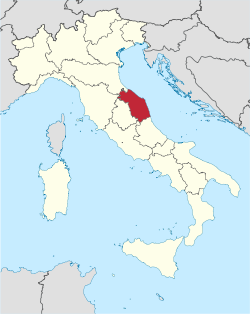 | |
| Country | |
| Capital | Ancona |
| Government | |
| • President | Francesco Acquaroli(Brothers of Italy) |
| Area | |
| • Total | 9,366 km2(3,616 sq mi) |
| Population (2012-10-30) | |
| • Total | 1,541,692 |
| • Density | 160/km2(430/sq mi) |
| Demonym(s) | Italian:Marchigiano(man) Italian:Marchigiana(woman) |
| GDP | |
| • Total | €42.597 billion (2021) |
| Time zone | UTC+1(CET) |
| • Summer (DST) | UTC+2(CEST) |
| ISO 3166 code | IT-57 |
| HDI(2021) | 0.903[2] very high·8th of 21 |
| NUTS Region | ITI |
| Website | Regione.Marche.it |
Marche(/ˈmɑːrkeɪ/MAR-kay,[3][4]Italian:[ˈmarke]), in English sometimes referred to asthe Marches(/ˈmɑːrtʃɪz/MAR-chiz),[5][6][7][8][9][10]is one of thetwenty regionsofItaly.The region is located in thecentral areaof the country, and has a population of about 1.5 million people, being the thirteenth largest region in the country by number of inhabitants.[11]The region's capital and largest city isAncona.[12]
The Marche region is bordered byEmilia-Romagnaand the republic ofSan Marinoto the north,TuscanyandUmbriato the west,Lazioto the southwest,Abruzzoto the south, and theAdriatic Seato the east. Except for river valleys and the often very narrow coastal strip, the land is hilly. A railway fromBolognatoBrindisi,built in the 19th century, runs along the coast of the entire territory. Inland, the mountainous nature of the region, even today, allows relatively little travel north and south, except by twisting roads over the passes.
From the Middle ages to theRenaissanceperiod, many cities of the Marche were important cultural, artistic and commercial centres, the most prominent beingAncona,Pesaro,Urbino,CamerinoandAscoli Piceno.[13]
Urbino, which was a major centre of Renaissance history, was also the birthplace ofRaphael,one of the most important painters and architects of that period.[14]The Marche region is also the birthplace ofGentile da Fabriano,Cyriacus of Ancona,Donato Bramante,Giovanni Battista Pergolesi,Giacomo Leopardi,Gioachino RossiniandMaria Montessori.
Toponymy[edit]
The name of the region derives from the plural of the medieval wordmarca,amarch or mark,that is, a border zone, originally referring to a borderland territory of theHoly Roman Empire,such as theMarch of Anconaand others pertaining to the ancient region.[15]
Geography[edit]

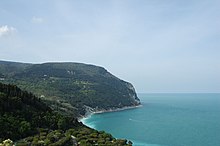
Marche extends over an area of 9,694 square kilometres (3,743 sq mi) of the centralAdriaticslope betweenEmilia-Romagnato the north,TuscanyandUmbriato the west, andLazioandAbruzzoto the south, the entire eastern boundary being formed by theAdriatic.TheUmbrianenclaveof Monte Ruperto (a subdivision of theComuneofCittà di Castello) is entirely surrounded by theProvince of Pesaro and Urbino,which constitutes the northern part of the region.
Most of the region is mountainous or hilly: theApenninerange runs longitudinally along the region's eastern border and descends through a hilly landscape towards theAdriaticsea. With the sole exception ofMonte Vettore,2,476 metres (8,123 ft) high, the mountains do not exceed 2,400 metres (7,900 ft). The hilly area covers two-thirds of the region and is intersected by wide gullies with numerous short rivers and by alluvial plains perpendicular to the Appennini range. The main mountain range has a few deep river gorges: the best known are those of theFurlo,the Rossa and theFrasassi.
The coastline is 173 kilometres (107 mi) long and is relatively flat and straight except for the hilly area betweenGabicceandPesaroin the north, and the eastern slopes ofMonte ConeronearAncona.
Climate is temperate. Inland, in the mountainous areas, is more continental with cold and often snowy winters; by the sea is more mediterranean. Precipitation varies from 1,000 to 1,500 millimetres (40 to 60 inches) per year inland and 600 to 800 mm (25 to 30 in) per year on the Adriatic coast.
A region with an annulardrainage patternpossibly corresponding to a muddiapirorastroblemeexists nearSant'Angelo in Pontano.[16]
As of 2023, according to the report on land consumption of the Higher Institute for Environmental Protection and Research, Marche andLiguriahold the Italian record for coastal overbuilding.[17][18]
Mountains[edit]
History[edit]
Marche was known in ancient times as thePicenumterritory. The first period of cultural unity of the Marches was in theIron Age,when the region was almost entirely inhabited by thePicentes.[19]Many artefacts from their time are exhibited inNational Archaeological Museum of the Marche Regionin Ancona. In the fourth century BC, the northern area was occupied by theSenones,a tribe ofGauls.TheBattle of Sentinumwas fought in Marche in 295 BC; afterwards, theRomansfounded numerous colonies in the area, connected to Rome by theVia Flaminiaand theVia Salaria.Ascoliwas a seat of Italic resistance during theSocial War (91–87 BC).
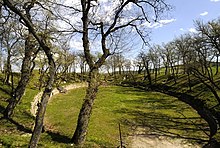
Following the fall of theWestern Roman Empire,the region was invaded by theGoths.After theGothic War,it was part of theByzantineExarchate of Ravenna(Ancona,Fano,Pesaro,Rimini,andSenigalliaforming the so-calledPentapolis). After the fall of the Exarchate, it was briefly in the possession of theLombards,but was conquered byCharlemagnein the late eighth century. In the ninth to eleventh centuries, the marches ofCamerino,FermoandAnconawere created, hence the modern name.
Marche was nominally part of thePapal States,but most of the territory was under local lords, while the major cities ruled themselves as free communes. In the twelfth century, thecommune of Anconaresisted both theimperial authorityofFrederick Barbarossaand theRepublic of Venice,and was amaritime republicon its own. An attempt to restore Papal suzerainty byGil de Albornozin the fourteenth century was short-lived.
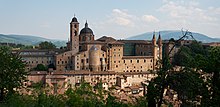

During theRenaissance,the region was fought over by rival aristocratic families, such as theMalatestaof Rimini,Pesaro,Fanoand the house ofMontefeltroofUrbino.The last independent entity, theDuchy of Urbino,was dissolved in 1631, and from then on, Marche was firmly part of thePapal Statesexcept during the Napoleonic period. This saw the short-livedRepublic of Ancona,in 1797–98; the merging of the region with theRoman Republicin 1798–99, and with theKingdom of Italyfrom 1808 to 1813; and the short occupation byJoachim Muratin 1815. After Napoleon's defeat, Marche returned to Papal rule until 4 November 1860, when it was annexed to theunified Kingdom of Italyby aplebiscite.
TheBombardment of Anconaoccurred during theAdriatic campaignof World War I. The1916 Rimini earthquakesdamaged or destroyed several buildings in Pesaro, Fano, and its hinterlands.[20][21][22]
TheBattle of Anconaoccurred during theItalian campaignof World War II.
After the referendum of 2006, 7 municipalities ofMontefeltrowere detached from theProvince of Pesaro and Urbinoto join theProvince of Rimini(Emilia-Romagna) on 15 August 2009.[23][24]The municipalities areCasteldelci,Maiolo,Novafeltria,Pennabilli,San Leo,Sant'Agata FeltriaandTalamello.
Towns in Marche were devastated by many powerful earthquakes during the centuries, the last time in 2016 (inAugustand inOctober).[25]
InSeptember 2022, Marche was hit by heavy flooding.[26]
Economy[edit]

Prior to the 1980s, Marche was considered a rather poor region, although economically stable in some sectors, thanks particularly to its agricultural output and to the contribution of traditional crafts.[27]
Today the contribution of agriculture to the economy of the region is less significant and the gross value generated by this sector remains slightly above the national average. Marche has never suffered from the extremes of fragmented land ownership or 'latifondo'. Greatly diffused in the past, the sharecropping never produced an extreme land fragmentation. The main products are cereals, vegetables, animal products and grapes. Truffle hunting is popular; although it has often led to 'truffle wars' between hunters due to the imposition of quotas. Olives are also produced and managed by various harvesters. In spite of the marine impoverishment, the sea has always furnished a plentiful supply of fish, the main fishing centres beingAncona,San Benedetto del Tronto,FanoandCivitanova Marche.[27]
Since the 1980s, the economy of the region has been radically transformed without, however, repudiating its rural past. Many of the small craft workshops scattered throughout the rural settlements have modernised and become small businesses, some of which have become major brands known all over the world (Indesit,Tod's,Guzzini, Teuco). This evolution led to the emergence of 'specialized' industrial areas, which are still profitable:
- footwear and leather goods in a large area straddling the provinces ofMacerataandFermo;
- furniture in thePesaroarea in particular;
- household appliances and textile industry in the province ofAncona,in which the main engineering companies are also to be found (including ship building, petrochemicals and paper, as well as consumer durables).
- The city ofCastelfidardoremains an important centre for the production of musical instruments, theaccordionin particular.
TheGross domestic product(GDP) of the region was 43.3 billion euros in 2018, accounting for 2.5% of Italy's economic output. GDP per capita adjusted for purchasing power was 28,200 euros or 94% of the EU27 average in the same year. The GDP per employee was 96% of the EU average.[28]
The unemployment rate stood at7.4%in 2020.[29]Marche is well known for itsshoemakingtradition, with fine and luxurious Italian footwear manufacturing facilities in the region.[citation needed]
Tourism[edit]
The region continues to draw tourists, whose increasing numbers have been attracted by the rich and broadly distributed heritage of history and monuments, as well as by the traditional seaside resorts.[27]Marche has many small and picturesque villages, 31 of them have been selected byI Borghi più belli d'Italia(English:The most beautiful Villages of Italy),[30]a non-profit private association of small Italian towns of strong historical and artistic interest,[31]that was founded on the initiative of the Tourism Council of the National Association of Italian Municipalities.[32]
Demographics[edit]
| Year | Pop. | ±% |
|---|---|---|
| 1861 | 909,000 | — |
| 1871 | 958,000 | +5.4% |
| 1881 | 972,000 | +1.5% |
| 1901 | 1,089,000 | +12.0% |
| 1911 | 1,145,000 | +5.1% |
| 1921 | 1,201,000 | +4.9% |
| 1931 | 1,240,000 | +3.2% |
| 1936 | 1,278,000 | +3.1% |
| 1951 | 1,330,352 | +4.1% |
| 1961 | 1,321,382 | −0.7% |
| 1971 | 1,340,444 | +1.4% |
| 1981 | 1,392,813 | +3.9% |
| 1991 | 1,409,876 | +1.2% |
| 2001 | 1,450,731 | +2.9% |
| 2011 | 1,538,699 | +6.1% |
| 2021 | 1,487,150 | −3.4% |
| Source:ISTAT | ||
The population density in the region is below the national average. In 2008, it was 161.5 inhabitants per square kilometre (418/sq mi), compared to the national figure of 198.8/km2(515/sq mi). It is highest in the province of Ancona (244.6/km2or 634/sq mi inhabitants per km2), and lowest in the province of Macerata (116.1/km2or 301/sq mi). Between 1952 and 1967 the population of the region decreased by 1.7% as a result of a negative migration balance, well above the national average, with a rate varying between 4.9 and 10.0 per 1,000 inhabitants. The Average fund of this region is worth about a few million or maybe higher. In the same period the natural balance of the population was positive, but lower than the national average and insufficient to counterbalance the net emigration. The population continued to decline until 1971, but in 1968 began growing again.[33]In 2008, theItalian national institute of statistics(ISTAT) estimated that 115,299 foreign-born immigrants live in Marche, 7.4% of the total regional population.
Government and politics[edit]
Marche forms, along with Emilia-Romagna, Tuscany and Umbria, the Italian "Red Quadrilateral",a strongly left-wing area. In the2014 European elections,the people of Marche gave 45% of their votes toMatteo Renzi'sDemocratic Party.
As of the2020 Marche regional electionMarche is governed by thecentre-right coalition.
Administrative divisions[edit]
The region is divided into fiveprovinces:Ancona,Ascoli Piceno,Fermo,Macerata,Pesaro e Urbino.
| Province | Abbreviation | Area (km2) | Population | Density (inhabitants/km2) |
|---|---|---|---|---|
| Province of Ancona | AN | 1,940 | 474,630 | 244.6 |
| Province of Ascoli Piceno | AP | 1,228 | 212,846 | 186.2 |
| Province of Fermo | FM | 859 | 177,578 | 206,6 |
| Province of Macerata | MC | 2,774 | 321,973 | 116.1 |
| Province of Pesaro and Urbino | PU | 2,564 | 364,896 | 141.9 |
References[edit]
- ^"Population on 1 January by age, sex and NUTS 2 region",ec.europa.eu
- ^"Sub-national HDI - Area Database - Global Data Lab".hdi.globaldatalab.org.Retrieved5 March2023.
- ^"Marche 2".The American Heritage Dictionary of the English Language(5th ed.). HarperCollins.Retrieved6 May2019.
- ^"Marche"(US) and"Marche".LexicoUK English Dictionary.Oxford University Press.Archived fromthe originalon 29 February 2020.
- ^Fodor's (13 March 2012).Fodor's Italy 2012.Random House Digital, Inc. p. 1132.ISBN978-0-87637-143-5.Retrieved24 April2012.
- ^Touring Club of Italy(1999).The Marches: A Complete Guide to the Region, Its National Parks, and Over a Hundred of Its Towns, Including Urbino.Touring Club of Italy. pp. front cover.ISBN978-88-365-1467-0.
- ^The Times, page[1](...British call it the Marches.).
- ^Facaros, Dana; Pauls, Michael (1 October 2007).Cadogan Guide Tuscany, Umbria & the Marches.New Holland Publishers. pp. front cover.ISBN978-1-86011-359-8.Retrieved24 April2012.
- ^"Marche 2".The American Heritage Dictionary of the English Language(5th ed.). HarperCollins.Retrieved6 May2019.
- ^"Marches".Collins English Dictionary.HarperCollins.Retrieved10 September2019.
- ^"Marche".Tuttitalia.it(in Italian).Retrieved18 January2023.
- ^"Le province delle Marche per popolazione".Tuttitalia.it(in Italian).Retrieved18 January2023.
- ^"Storia Marche".comuni-italiani.it.Retrieved18 January2023.
- ^"Raphael | Biography, Artworks, Paintings, Accomplishments, Death, & Facts | Britannica".britannica.Retrieved18 January2023.
- ^"Marche, unica regione d'Italia al plurale: ma perché si chiamano così?".AnconaToday(in Italian).Retrieved13 December2021.
- ^Colucci, Sabrina; Fidani, Cristiano (2022)."Preliminary geomorphological and hydrographical characterization of a circular structure in the Marche Region (Central Italy) and its possible origin".Géomorphologie.28(2): 126–136.doi:10.4000/geomorphologie.17007.S2CID250379245.
- ^"Liguria, the future razed to the ground".5 December 2023.
- ^"Report for the consumption of soil"(in Italian). Istituto superiore per la protezione e la ricerca ambientale.
- ^"Origine e area di diffusione della civiltà dei piceni".antiqui.it.Retrieved18 January2023.
- ^"8 dicembre 1916 - Legge speciale per Rimini distrutta dal terremoto"[8 December 1916 – Special law for Rimini destroyed by the earthquake].Chiamami Città(in Italian). 7 December 2023.Retrieved4 January2024.
- ^"Terremoto del 17.05.1916, Alto Adriatico (Rimini)"[Earthquake of 17 May 1916, High Adriatic (Rimini)].lavalledelmetauro.it.28 July 2004.Retrieved4 January2024.
- ^"Pesaro. Fai, per le Giornate di Primavera monumenti aperti"[Pesaro, FAI: Monuments open for the Spring Days].La Piazza(in Italian). 22 March 2019.Retrieved11 January2024.
- ^"Article about the legislation".Archived fromthe originalon 22 July 2011.
- ^(in Italian)Articleon "il Resto del Carlino"
- ^Powerful Earthquakes in Italy.
- ^Alluvione Marche, 8 morti e 4 dispersi: si cerca un bambino, salva la mamma. Dispersa un'altra madre con bimba,Il Messaggero
- ^abc"Eurostat".Circa.europa.eu. Archived fromthe originalon 21 July 2011.Retrieved23 April2010.
- ^"Regional GDP per capita ranged from 30% to 263% of the EU average in 2018".Eurostat.
- ^"Unemployment NUTS 2 regions Eurostat".
- ^"Marche"(in Italian). 9 January 2017.Retrieved1 August2023.
- ^"Borghi più belli d'Italia. Le 14 novità 2023, dal Trentino alla Calabria"(in Italian). 16 January 2023.Retrieved28 July2023.
- ^"I Borghi più belli d'Italia, la guida online ai piccoli centri dell'Italia nascosta"(in Italian).Retrieved3 May2018.
- ^"Eurostat".Circa.europa.eu. Archived fromthe originalon 21 July 2011.Retrieved23 April2010.
External links[edit]
 Marchetravel guide from Wikivoyage
Marchetravel guide from Wikivoyage- Official website



